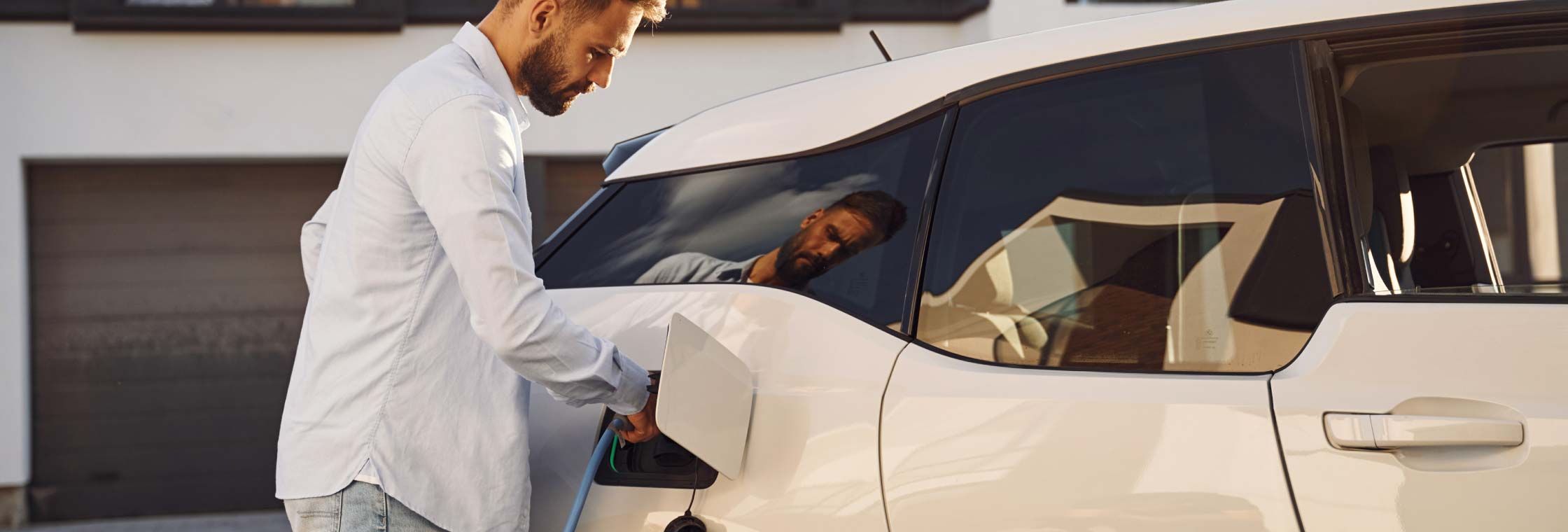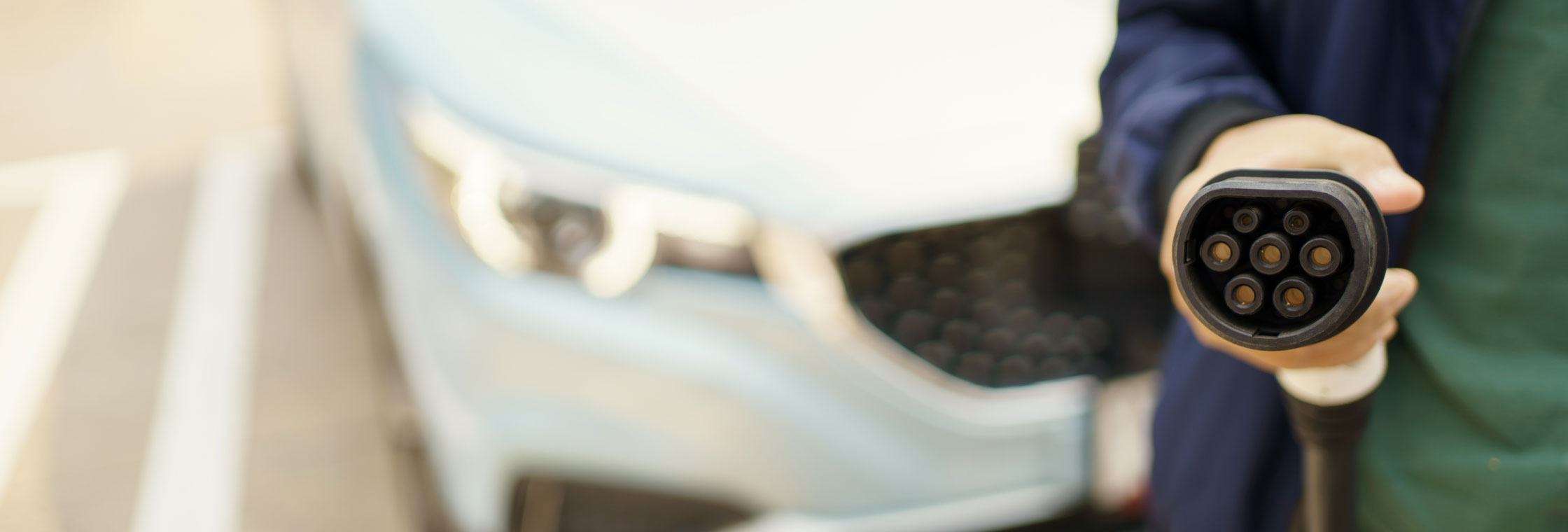EVs can be charged at a wider range of places than petrol cars, which must be filled at petrol stations.
Most people can charge their EVs at home using either a slow charger or a faster charger that’s installed by a professional electrician.
Have you recently bought an electric vehicle (EV) or are considering making the switch? There are a few things you may need to consider that differ when driving a petrol or diesel car.
The most common difference is the way you re-fuel EVs, often known as charging. As an EV owner, it’s important to know what’s needed to charge at home or while on the road. We’ll explore some of the key things you need to know after buying an EV.

EVs can be charged at a wider range of places than petrol cars, which must be filled at petrol stations.
Most people can charge their EVs at home using either a slow charger or a faster charger that’s installed by a professional electrician.
Charging an EV at home is the most convenient option for many EV owners. Most new EVs in Australia come with slow chargers, or you can purchase one to use at home or at work.
Slow chargers plug into most electrical wall sockets. To charge at home, simply plug in the slow charger like you’d plug in your phone.
You can also purchase faster EV chargers for home charging, but these must be installed by a professional electrician. The price of these installs varies depending on the charger, but, in most cases, installations can be done for under $2,000, including the charger. Most of these are installed with single-phase power, which doesn’t require extensive re-wiring or a long time to install.
With home charging, EVs can leave home with a full charge every morning without needing a public charging station.
If you don’t have off-street parking or live in an apartment building without a dedicated charging station, you won’t have the option to charge at home. There are a growing number of public charging stations that you can use instead.
You can also charge your EV at public chargers if you don’t have off-street parking’. It costs more to charge here, but an hour’s charge can typically add around 70km range in an hour.
According to data from carloop, there are over 3,000 regular charging stations across Australia as of 2023. This is growing at a rapid pace too, with many local councils coming on board to install more of these chargers at council civic centres, libraries, sports facilities, and along shopping strips.
You can find most of these locations on crowd-sharing charging map websites. These sites also provide EV owner with reviews of the charging stations and any local amenities around the searched map area.
To charge at public charging stations, you need to bring the correct cables and download the respective charging app to go with it.

When using public charging stations, you might need additional cables. Think of these like the cables you use to charge a phone, but slightly thicker.
These are called Type 2 to Type 2 cables and can be used with most modern EVs and public chargers.
The length, charge rate, and quality of these cables vary from supplier to supplier so it’s worth checking the compatibility of these with your EV.
Once you have one of these cables, it’s best to keep them in your car as you may need them while on the road.
On top of the different charging cable types, you may need to access chargers across the country. This can be done using charge point operator apps.
Public charging is available to all EV drivers. Many locations have a set fee and, depending on the charge point operator of the charger, many require you to download an app and have an account with the operator.
Some of the more popular charging operators in Australia include:
The apps for these networks can be downloaded from either the Apple Store or Google’s Play Store. You’ll also need to sign up to be able to use the chargers that are on that operator’s network. To save time and avoid any possible delays with activating a new account, download the apps before you start your trip.
Other regular public charging stations are also available at shopping centres and strips. Although these are slower to charge, they’re generally free for customers.
Tesla has its own supercharging network, which can be considered as a “public” charging station network. As of 2023, the network is limited to Tesla cars in Australia, with only a handful of sites being opened to non-Tesla vehicles. Tesla will be growing this network significantly in Australia over the next couple of years.
Charging a Tesla at these superchargers is as easy as:
There’s no need to even pull out your phone or load an app. Tesla will automatically charge the registered owner for the charging session, which minimises any hassles. It’s a similar experience to taking an Uber and hopping out when you’re at the destination.
On the other hand, all non-Tesla EV drivers need to download the Tesla app and set up their account before they can start using the Tesla Supercharger network.
We’re likely to see more Tesla superchargers in Australia in the coming years as the number of EVs continues to rise.
As well as charging cables, you can also get accessories for your EV to improve your overall ownership experience. Some of these accessories include:
These accessories can be purchased from either the manufacturer or from specialist accessory stores.
You may be happy with just what comes with the car, but it’s good to know that there are options for those looking at getting accessories too.
EVs are new for many drivers and some of us may like to meet like-minded EV drivers. The good news is that EV community groups exist across all states and territories in Australia.
Two of these main groups include the AEVA (Australian Electric Vehicle Association) and TOCA (Tesla Owners Club of Australia). These groups are made up of like-minded EV owners who are happy to share their knowledge at regular meetings and events. Some even offer drive events and regular coffee catch ups.
It’s also worth noting that these groups do have a small annual membership fee, but it comes with lots of membership benefits such as discounts on charging equipment and accessories.
Buying an EV is an exciting time for many. With the convenience of charging at home or at fast charging stations for a quick top-up, it's always good to be prepared.
Having the right cables and apps to charge your car always helps to make all EV journeys smoother.
On top of that, learning from like-minded EV owners is a good way to make the most out of owning a new electric car.
This article has been prepared by Allianz Australia Insurance Limited ABN 15 000 122 850 AFSL234708 ("Allianz"). In some cases, information has been provided to us by third parties and while that information is believed to be accurate and reliable, its accuracy is not guaranteed in any way.
Any opinions expressed constitute our views at the time of issue and are subject to change. Neither Allianz, nor its employees or directors give any warranty of accuracy or accept responsibility for any loss or liability incurred by you in respect of any error, omission or misrepresentation in this article.
Any advice here does not take into account your individual objectives, financial situation or needs. Terms, conditions, limits, and exclusions apply. Before making a decision about this insurance, consider the relevant Product Disclosure Statement (PDS)/Policy Wording and Supplementary PDS (if applicable). Where applicable, the PDS/Policy Wording, Supplementary PDS and Target Market Determination (TMD) for this insurance are available on this website. We do not provide any form of advice if you call us to enquire about or purchase a product.
Allianz Australia Insurance Limited ABN 15 000 122 850 AFS Licence No. 234708 is the insurer of any general insurance products offered, and Allianz Australia Life Insurance Limited ABN 27 076 033 782 AFS Licence No. 296559 is the insurer of any life insurance products offered. Each entity is responsible for any statements and representations made about its products, on this website.